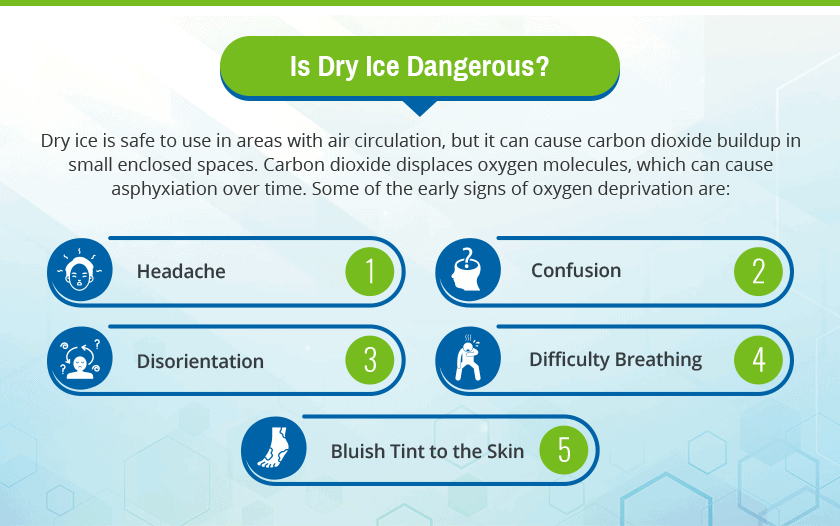How Dry Ice is Made
What Is Dry Ice?
Dry ice is made by liquefying carbon dioxide and injecting it into a holding tank, where it’s frozen at a temperature of -109° F and compressed into solid ice. Depending on whether it’s created in a pelletizer or a block press, dry ice can then be made into pellets or large blocks.
Unlike regular ice, dry ice doesn’t melt into a liquid as it warms up. Instead, it converts directly back into its gaseous form in a process known as sublimation. At -109° F, dry ice is also significantly colder than the 32° F surface temperature of regular ice.

Dry Ice History
Dry ice was discovered in the early 1900s and first entered commercial production in the 1920s. The name “dry ice” has been used since 1925, when a manufacturer first trademarked it. Commonly found in commercial settings, the compound is versatile and offers benefits to a broad variety of industries.
The food and agriculture sector, for example, uses dry ice to keep food from spoiling during transport. Because of its low temperature, dry ice inhibits bacterial growth and slows decay, which makes the food crisper, fresher, and flavorful for as long as possible.
There are a multitude of other applications in commercial settings. The entertainment industry, for example, uses dry ice to create a smoky effect without an open flame.
Pest control technicians use it to force gophers out of their holes, which lets the technician close the burrows without hurting wildlife. Dry ice can also attract mosquitoes away from people and clean delicate electronics without corrosive chemical solvents.
Dry Ice Safety

Anyone can take advantage of the many benefits of dry ice, but there are several safety techniques to keep in mind:
- Wear heavy gloves before handling dry ice, as it can cause frostbite if it’s touched directly.
- While it’s safe to use dry ice near food, it should never be ingested, as it can cause internal frostbite.
- Only use dry ice in well-ventilated areas and don’t let the concentration of carbon dioxide in the air reach 5% or higher.
Frequently Asked Questions About Dry Ice
The following guide explains the answers to a few commonly asked questions about how to safely handle dry ice.
Is Dry Ice Dangerous?

Dry ice is safe to use in areas with air circulation, but it can cause carbon dioxide buildup in small enclosed spaces. Carbon dioxide displaces oxygen molecules, which can cause asphyxiation over time. Some of the early signs of oxygen deprivation are:
- Headache
- Confusion
- Disorientation
- Difficulty breathing
- Bluish tint to the skin
Because dry ice releases carbon dioxide gas, you also shouldn’t store the material in an airtight container. Otherwise, gas buildup can pressurize the container and cause it to burst.
Be cognizant of the types of materials that interact with dry ice. Glass, ceramic, stoneware, plastic, and other surfaces can crack if they’re exposed to dry ice because of the dramatic temperature difference. It’s common to use Styrofoam coolers to transport and store dry ice because it won’t crack, is insulative, and lets carbon dioxide disperse safely.
If you touch dry ice without wearing protective gear, it can cause frostbite. Always wear gloves when handling the material and consider using tongs to move pieces instead of handling them directly.
What Is the Dry Ice Formula?
Dry ice has just one ingredient: carbon dioxide. Technicians create dry ice by pumping liquid carbon dioxide into holding tanks, which reduces the temperature to -109° F and pressurizes the substance into solid blocks or pellets.
What Is the Difference Between Dry Ice and Liquid Nitrogen?
Liquid nitrogen is much colder than dry ice—usually between -346°F and -320.44°F—which also makes it more dangerous to handle. Because it’s a liquid and not a solid, it’s also more challenging to work with in many settings and can be difficult to contain.
Liquid nitrogen is commonly used as a refrigerant due to its very low temperature, food freezing, storage of biologics in specialized freezers and thermal grain refinement in metallurgy are typical however it is most commonly used as an efficient method to store or transport gaseous nitrogen.
Dry ice while not nearly as cold serves as a method of shipping frozen goods because it can stay cold for up to 7 days in engineered shipping cartons.
Dry ice is also used in the food processing industry to prevent spoilage during large scale blending or grinding processes such as hamburger production, dry ice pellets are added directly to the grinding process to keep the temperature of the grind below the bacterial growth temperature range, liquid nitrogen is usually too cold for these applications.
Contact the Experts at CryoCarb
CryoCarb is the leading dry ice manufacturer in northern Illinois and southern Wisconsin. We provide dry ice solutions for commercial and retail settings that are safe and easy to use. To learn more about the many applications of dry ice, contact us today.
